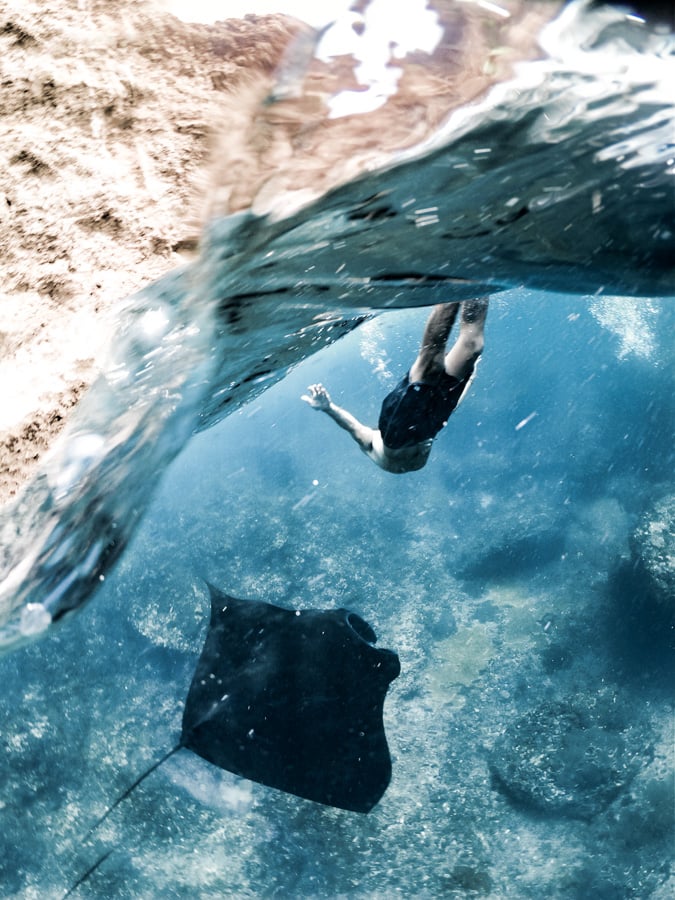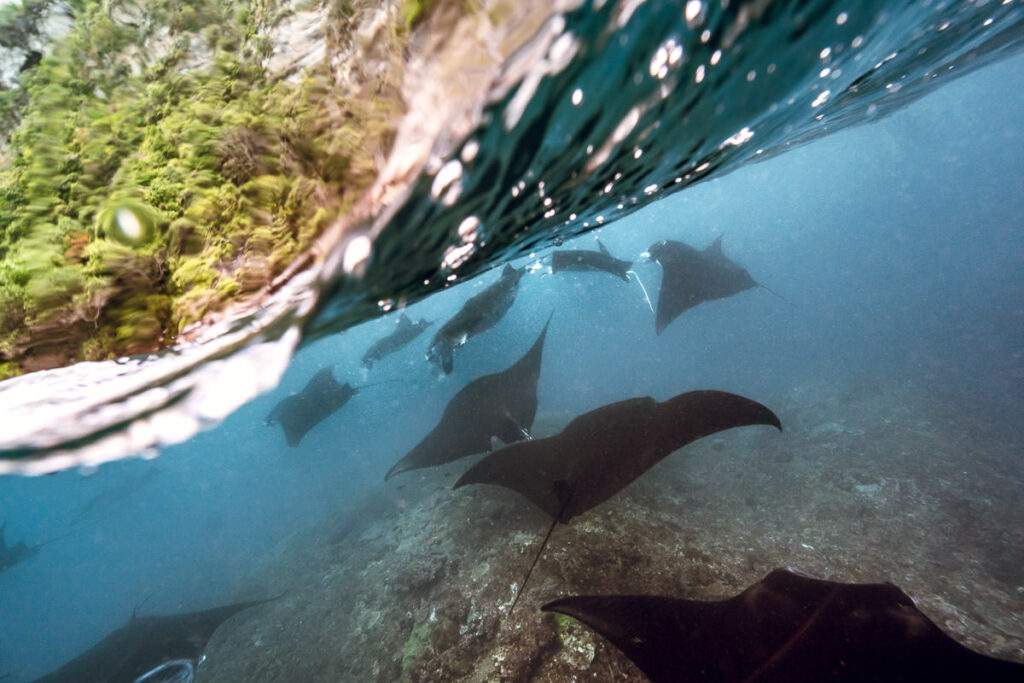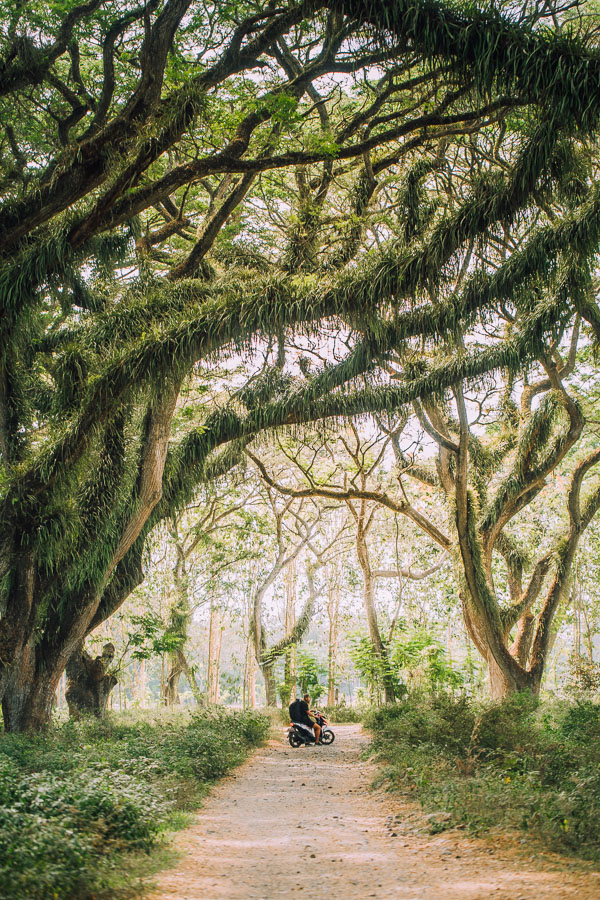
Snorkeling with Manta Rays at Manta Point on Nusa Penida is a once-in-a-lifetime experience. Nusa Penida is an island just off the coast of mainland Bali, which takes just 35 minutes to reach by fastboat. The Manta Rays are majestic and very friendly. With a wingspan of 5m, these gentle giants cruise around you while you snorkel amongst them. This Nusa Penida Manta Ray Snorkel Tour includes pick up and drop off from your hotel in Bali and all transport and tickets included.

Snorkeling with Giant Manta Rays on Nusa Penida
In this blog post, I’ll also detail how and where to book the best Manta Ray Snorkeling Tours and give you all of the tips you need to know before you snorkel with GIANT Manta Rays at Manta Point in Nusa Penida. I’ll also share my honest experience of the tour and leave you with all the information you need to know about snorkeling with Giant Manta Rays at Manta Point in Nusa Penida.

BOOK A MANTA RAY SNORKEL TOUR FROM BALI
If you are based in Canggu, Kuta, or Seminyak in Bali you can book this Manta Ray Snorkeling tour that will pick you up from your hotel in Bali. It has thousands of reviews and is priced quite well considering it includes pick-up and drop-off to your hotel as well as the fast-boat to and from Bali mainland.
CLICK HERE TO BOOK YOUR TOUR: Manta Ray Snorkeling Tour
The tour includes lunch, and several other snorkeling spots near Manta Point where you can see turtles, corals and tropical fish. You’ll also cruise through a few beaches on top of the Manta Point snorkel.

MANTA RAY SNORKELING TOUR AVAILABILITY
You can use this calendar below to see the availability of tours. It’s important to book this tour in advance during high season as it can be a very popular activity on Nusa Penida and they try and limit the number of boats in the water.

BOOK A MANTA RAY SNORKELING TOUR FROM NUSA PENIDA
You can book a tour locally if you are already on Nusa Penida or Nusa Lembongan. To book a tour from Nusa Penida just head down to Crystal Bay and find a vendor as that is where you will launch off from. To book a tour on Lembongan, head down into the main street and you will find many tour offices who all sell the tour at the same price more or less.
However, it can often be less challenging and more convenient to book online with pick-up included if you aren’t cruising on your own motorbike. Therefore, I suggest this tour: Snorkeling with Manta Rays from Nusa Penida or Snorkeling with Manta Rays from Nusa Lembongan. These tours cost less than the tour I mentioned earlier that departs from Bali as you don’t need the speed boat and transfers on mainland Bali.

MY EXPERIENCE SNORKELING WITH MANTA RAYS AT MANTA POINT
I have experienced both the tour from Nusa Penida and the tour from Nusa Lembongan and both were very relaxing and great experiences. Our boat drove us the 20 minutes to Manta Point as we took in the beautiful coastline of Nusa Penida. Once we arrived at Manta Point, the captain looked for any Manta Rays and they are very good at spotting them before you even have your snorkel ready.
When we jumped into the water we were immediately staring face to face with a giant Manta Ray, which is one of the most majestic creatures of the ocean. I didn’t expect it at all, I thought we would be waiting around for the More than five Manta Rays playfully looped around the bay, entertaining the group of snorkelers. The Manta Rays always seem playful and loop back again and again unlike turtles or fish, which often swim away at the sight of humans. The Manta Rays will often actually head straight for you and then dart off to the side at the last minute.

The Giant Manta Ray isn’t dangerous but it is still intimidating when a 5-meter creature swims straight at you before ducking away at the last moment.
We hung out in the bay until we could hardly swim anymore. The experience was unreal. I think this was even better than swimming with Whale Sharks in the Philippines.

BEST CAMERA FOR BALI
The GoPro Hero11 is the BEST camera for traveling around Bali and Indonesia.
- Waterproof for snorkeling, island-hopping, hiking and beach days.
- Built-in stabilization for filming your travels and adventure activities
- 5.3K video and 27MP Photo to capture awesome memories of friends and family
Things to know about Manta Point
Manta Point in Nusa Penida, Indonesia, is a well-known dive spot famous for the manta rays that often frequent its waters. It is located on the southern side of Nusa Penida, an island off the coast of Bali.
The site is characterized by its relatively shallow waters, with the depth varying between 7 to 20 meters. This makes it suitable for both beginner and experienced divers. The water clarity can change depending on the time of year and the weather conditions, but it’s usually quite good.

The main draw of Manta Point is, of course, the manta rays. These beautiful and majestic creatures often visit the area to feed on the plankton that accumulates near the surface. Divers can see them gliding gracefully in the water, and it’s a sight that leaves many in awe. The size of the mantas can reach up to 7 meters from wingtip to wingtip.

Other marine life can also be seen in Manta Point, including various species of fish, turtles, and occasionally reef sharks. However, it’s worth noting that the currents can be quite strong, so it’s always advisable to dive with an experienced guide.
In addition to diving, snorkeling is also popular at Manta Point, as the mantas often swim close to the surface. This makes it an accessible location for those who are not divers but still wish to see these magnificent animals.

Best time of year to visit Manta Point on Nusa Penida
Manta Point in Nusa Penida, Indonesia, is a year-round dive site. You can visit at any time of the year and still have a chance to see the manta rays.
However, there are some considerations depending on the time of the year. The water temperature in Nusa Penida can vary, being cooler from July to October, around 22-26 degrees Celsius (72-79 degrees Fahrenheit), and warmer from November to June, around 27-30 degrees Celsius (81-86 degrees Fahrenheit).
The visibility can be a bit lower during the rainy season, which typically lasts from December to March. Although manta rays can still be seen during this period, rough seas might make the boat ride to the dive site more challenging, and the water conditions can also be less predictable.
The dry season, from April to November, often offers better conditions with calmer seas and better visibility. The highest chance to encounter manta rays is typically from April to May and from September to November, but these graceful creatures are known to frequent Manta Point throughout the year.

MANTA POINT VIEWPOINT
As you finish up at Angel’s Billabong it is common to walk around the corner to Broken Beach. The walk only takes 5 minutes but halfway through the journey is an archway made of trees. When you reach this archway don’t go through immediately! Head up the hill towards the coast on your right and look down into the ocean. This is where the Giant Manta Rays hang out.
We sat on the cliffs watching the Mantas cruise around and surface time and time again. It was a pretty awesome discovery and we have aptly named the cliff, ‘Manta Point Viewpoint’.

THINGS TO KNOW ABOUT GIANT MANTA RAYS
- Scientific Name: The scientific name of the giant manta ray is Mobula birostris. It was previously classified as Manta birostris.
- Size: Giant manta rays are the largest species of rays, with a wingspan that can reach up to 9 meters (30 feet). Despite their size, they are graceful swimmers.
- Weight: These creatures can weigh up to 3,000 kilograms (approximately 6,600 pounds).
- Diet: Manta rays are filter feeders. They eat large quantities of zooplankton in the form of shrimp, krill, and planktonic crabs.
- Habitat: Manta rays inhabit the tropical, subtropical, and temperate oceans around the world. They are typically found near the surface or mid-water, but can dive to depths of at least 1,000 meters (3,280 feet) when necessary.
- Social Behaviour: Giant manta rays are known for their curiosity and will often interact with divers. They are generally solitary creatures but can be found in groups, particularly in areas with abundant food or at cleaning stations where small fish remove parasites from their bodies.
- Reproduction: Manta rays have a low reproduction rate, with females giving birth to only one pup every two to three years after a gestation period of around a year. This slow reproduction rate makes them particularly vulnerable to threats like overfishing.
- Longevity: The lifespan of a giant manta ray is believed to be about 20 to 25 years, but this could be an underestimate as many aspects of their lives remain a mystery.
- Threats and Conservation: Major threats to giant manta rays include overfishing, pollution, habitat loss, and entanglement in fishing gear. They are currently listed as vulnerable by the International Union for Conservation of Nature (IUCN).
- Intelligence: Manta rays are believed to be among the most intelligent of all fish. They have the largest brain-to-body ratio of any fish, and they have been observed exhibiting complex behaviors such as coordinated and cooperative feeding, recognition of self in mirrors, and even social interactions.

BEST NUSA PENIDA DAY TOURS
If you are staying in Bali.. take a day trip on a speedboat to explore the highlights of Nusa Penida. It takes just 35 minutes to get from Bali to Nusa Penida by speed boat. Yep, in just one day you can snorkel with Manta rays and visit lots of the best beaches and viewpoints.
Manta Ray Snorkeling Tour
Manta Ray Nusa Penida Tour (from Bali): Snorkeling with Manta Rays is a once-in-a-lifetime experience and one of the best wildlife encounters I’ve had in my life. The Manta Rays are majestic and very friendly. With a wingspan of 5m, these gentle giants cruise around you while you snorkel amongst them. The Nusa Penida Manta Ray Snorkel Tour includes pick up and drop off from your hotel in Bali and all transport and tickets included.

Nusa Penida Highlights Tour
Nusa Penida Highlights Tour: Get picked-up from your Bali hotel, take a 35-minute fast boat to Nusa Penida and then visit the most popular viewpoints, beaches and snorkel spots on the island. This small Nusa Penida Highlights Tour group tour is the most highly reviewed day trip for Nusa Penida Island. You’ll visit all the most popular spots and can request certain viewpoints on your itinerary. Places you will visit are sites like the ones listed below:
- Angel’s Billabong
- Kelingking T-Rex Beach
- Broken Beach
- Rumah Pohon Treehouse
- Snorkeling at Crystal Bay
- Thousand Island Viewpoint

How to get to the Nusa Islands
There are three main options to get to Nusa Penida depending on your budget and how many logistics you want to manage. Here are the three options with the cheapest first:
- Book your ticket: Sanur (Bali) to Nusa Lembongan – Book a regular ferry that leaves from Sanur to Nusa Penida on the reliable website 12go. You then need to moped or taxi across to Nusa Penida via another ferry/boat.
- Book a fast boat: Sanur (Bali) to Nusa Penida – This option is great as you go direct from Bali to Penida without having to stop in Lembongan. This option is only slightly more expensive than stopping in Lembongan. This is my favorite option of the three and can be booked on Klook.
- Book a fast boat with hotel-pick up: Sanur (Bali) to Nusa Penida – This option includes a fast boat from Sanur (Bali) to Nusa Penida but also includes pick up from your hotel in Bali in a van. This option from GetYourGuide is a bit more expensive but takes all the hassle out of the transit from Bali to Nusa Penida.

MORE NUSA ISLANDS BLOG POSTS
There are a ton of epic things to do on Nusa Penida, but I also wrote detailed guides for all of the adventurous things to do on Nusa Lembongan, Nusa Ceningan. You can explore more of my guides by clicking one of the links below.



